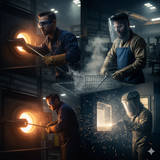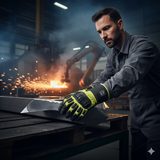From Toe to Tread: Your Essential Guide to Selecting Safety Footwear (Steel, Composite, and Beyond)
In countless workplaces, from the bustling construction site to the busy warehouse, the factory floor, and even in many office-adjacent roles, our feet are constantly at risk. Dropped tools, falling materials, sharp objects, slippery surfaces, and even electrical hazards pose a constant threat to these vital extremities.
Yet, "safety boots" are often treated as a generic requirement, without considering the specific hazards they need to protect against. Just like a hard hat or safety glasses, selecting the right safety footwear isn't a "one-size-fits-all" decision; it's a critical choice that directly impacts an employee's safety, comfort, and productivity.
At Your Safety Company, we understand that protecting your team means starting from the ground up. Let's step through the essential factors in selecting safety footwear that truly meets the demands of the job.
More Than Just a Boot: Understanding the Risks
Foot and leg injuries can be debilitating and costly. The common hazards that proper safety footwear guards against include:
-
Impact & Compression: From heavy falling or rolling objects (e.g., tools, equipment, materials).
-
Punctures: From stepping on sharp objects like nails, screws, glass, or metal shavings.
-
Slips, Trips, and Falls: From wet, oily, icy, or uneven surfaces.
-
Electrical Hazards: From contact with live electrical circuits.
-
Chemical Exposures: From splashes or prolonged contact with corrosive or hazardous liquids.
-
Cuts and Lacerations: From sharp tools, machinery, or moving parts.
-
Fatigue: From prolonged standing on hard surfaces.
Decoding Safety Footwear: Key Features and Standards
Modern safety footwear is engineered with specific features to combat these hazards. Understanding the common features and how they're certified (often to ASTM standards in the U.S.) is crucial:
-
Protective Toe Caps (Impact & Compression Protection):
-
Steel Toe: The traditional and strongest option. Offers maximum protection against crushing and impact.
-
Composite Toe: Made from non-metallic materials (e.g., carbon fiber, fiberglass, plastic). Lighter than steel, does not conduct heat/cold, and is non-magnetic (important for environments with metal detectors or electrical hazards).
-
Alloy Toe: Lighter than steel, but still very strong. Often a thinner profile than steel, providing more toe room.
-
-
Puncture Resistance (PR):
-
Features a flexible, woven plate (often steel, composite, or textile) embedded in the sole to prevent sharp objects from penetrating from below. Essential in construction or waste management.
-
-
Electrical Hazard (EH) Protection:
-
Electrical Hazard (EH) Rated: Designed to be a secondary source of protection on substantially dry surfaces by reducing the flow of electricity through the sole. Outsoles are non-conductive and designed to insulate.
-
Conductive (CD) Rated: Designed to dissipate static electricity from the body to the ground, reducing the risk of static discharge in environments with flammable materials.
-
Static Dissipative (SD) Rated: Reduces excess static electricity, often used in electronics manufacturing or explosive environments.
-
-
Slip Resistance:
-
The outsole tread pattern and rubber compound are engineered to provide maximum traction on wet, oily, or icy surfaces. Look for specific certifications or ratings for slip resistance.
-
-
Metatarsal Guards (MT):
-
External or internal guards that protect the top of the foot from impact and crushing injuries (e.g., from heavy falling objects). Crucial in heavy industrial environments.
-
-
Other Important Features:
-
Waterproof/Water-Resistant: For working in wet conditions.
-
Insulation: For cold weather environments.
-
Chemical Resistance: Specialized materials for protection against specific chemicals.
-
Comfort & Ergonomics: Proper arch support, cushioning, and fit reduce fatigue and increase wearer compliance.
-
Selecting the Best Fit for Your Team
To ensure your employees have the best protection, follow these steps:
-
Conduct a Hazard Assessment: Identify all potential foot hazards present in each job role and specific work area.
-
Match Features to Hazards: Choose footwear with features (e.g., steel toe, EH, PR, slip resistance) that directly address the identified risks.
-
Consider the Environment: Account for heat, cold, wetness, and chemical exposure.
-
Prioritize Comfort and Fit: An uncomfortable boot won't be worn consistently. Offer choices where possible and ensure proper sizing.
-
Inspect Regularly: Encourage employees to inspect their footwear for wear and damage, replacing them when protection is compromised.
Your Safety Company: Stepping Up Your Foot Protection
Investing in the right safety footwear is a foundational element of any comprehensive workplace safety program. It safeguards your employees from serious injuries and contributes to a more productive and confident workforce.
At Your Safety Company, we offer an extensive selection of safety footwear designed to meet the rigorous demands of various industries. From heavy-duty steel-toe boots with metatarsal guards to lightweight composite-toe shoes with advanced slip resistance, we have the specialized solutions you need to protect your team.
Don't compromise on foot safety. Visit yoursafetycompany.com today to explore our full range of safety footwear and ensure your team is well-protected from toe to tread.
Recent Posts
-
More Than Goggles: The Specialized Eye Protection Needed for High-Heat Industrial Environments
In facilities that process metal at extreme temperatures, eye safety is a complex, multi-layered cha …12th Nov 2025 -
Double Defense: Why Cut and Impact Protection is Critical for Material Handling
In facilities that deal with heavy metal parts, sharp edges, and complex machining, a standard work …11th Nov 2025 -
Beyond the Flame: Why NFPA 2112 FR Apparel is Non-Negotiable
In high-risk industrial settings—from petrochemical plants and utilities to metal processing and hea …7th Nov 2025



